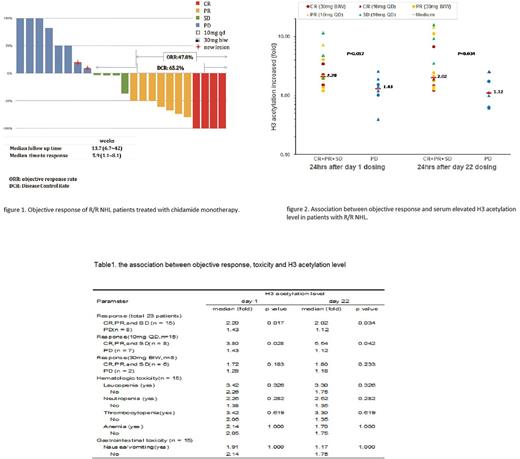Abstract
INTRODUCTION: Chidamide as the first oral subtypeselective histone deacetylase inhibitor (HDACI) has been approved for treatment of refractory/relapsed peripheral T-cell lymphoma (R/R PTCL) by the China Food and Drug Administration (CFDA).(Lu X, Intractable Rare Dis Res. 2016) A multicenter phase II study showed that the overall response rate (ORR) was 28 % and complete response (CR/CRu) ratewas14 %.(Shi Y, Ann Oncol. 2015) However, the association between therapeutic efficacy and H3 acetylation level change inprevious HDACI clinical studies is not well defined. The objectives of the current study were to evaluate the clinical response and toxicity of R/R-NHLpatients treated with chidamide, and try to investigatethe association between objective response and H3 acetylation level. (NCT 02878278)
METHODS:
Patients with R/R-NHL were enrolled in this Phase II, open-label study. Two-dosing schedule of chidamidemonotherapy was administrated (10mg QD and 30 mg BIW). Blood samples were collected predose and up to 4, 8, 16, 20, 24h after each chidamide dose on day 1 and day 22. Response, safety profile and H3 acetylation level were assessed. Total histones were isolated and purified from WBC samples collected at referred time points. All statistical analyses were performed using the Statistical Package for the Social Sciences (SPSS) 18.0 software.
RESULTS:
Twenty-five R/R-NHL patients who had failed to standard therapy were enrolled, and allpatients already have been treated ≧ 2 lines of chemotherapy (median 4, and range, 2-8) Dosing schedule of chidamide included 10mg QD group, n = 16 ,and 30 mg BIW group, n = 9, respectively. Final response was evaluable in 23 (92.0 %) patients(figure 1), while2 patients withdrew from study due to progressive disease (PD) two weeks after chidamide administration. Serum samples detection showed, thatH3 acetylation level increase was consistent and slightly escalation during dosing on 10mg QD, while fluctuating change during dosing on 30mg BIW. The H3 acetylation level increased by 2.06 folds from the first dose at day 1, and was maintained at a high levelat day 22 in 10 mg QD group. In the 30 mg BIW group, the H3 acetylation level was also increased by 1.53 folds from the first dose at day 1, and slightly accumulated at a high level subsequent administration, although there was a period of low acetylation in the middle of the two administrations. Patients with increased H3 acetylation level would likely to getobjective responses tochidamide treatment compared to progressed patients without increased H3 acetylation. (14: 9 patients at day 1, and 14:7 patients at day 22, respectively.) A significant positive association between therapeutic response of chidamide and elevated H3 acetylation level in plasma was found in our cohort (P = 0.017, day 1, and P = 0.034, day 22, figure 2 ). Subgroup analysis showed that CR/PR/SD patients (n = 8)had statistical increased H3 acetylation levels compared to PD patients (n = 7) in 10 mg QD group. (median fold : 3.80 vs 1.43, day 1, p = 0.028 ,and 5.54 vs 1.12, day 22, p = 0.042 ) The similar results was found in 30 mg BIW group, however, not reach statistically significant (median fold : 1.72 vs 1.28, day 1, p = 0.183 and 1.80 vs 1.18, day 22, p = 0.233 ). The main adverse events (AEs) were hematologic toxicity and mild gastrointestinal toxicity. There were no statistical difference of the H3 acetylation level in CR/PR/SD patients between 10mg QD and 30 mg BIW group (p = 0.315), and there were no significant association between the H3 acetylation level and toxicity of chidamide.(table 1)
Conclusions:
Preliminary results of the present study suggestedthatchidamide monotherapy yielded promising efficacy with mild toxicity for patients with R/R-NHL. Our findings suggested that elevated H3 acetylation level might be a response biomarkerfor chidamide. Further investigation is urgently needed.
No relevant conflicts of interest to declare.
Author notes
Asterisk with author names denotes non-ASH members.


This feature is available to Subscribers Only
Sign In or Create an Account Close Modal